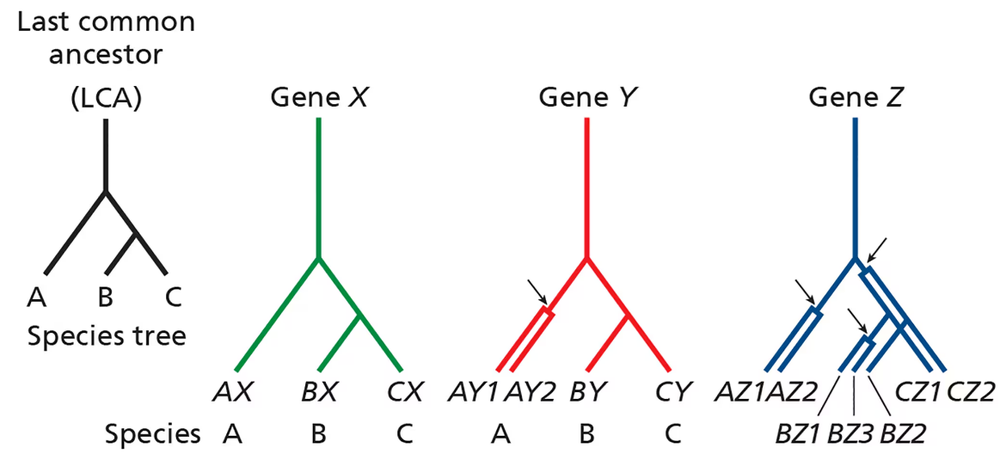We all carry about 20,000 genes in our genome. So far, patents have been issued for more than 6000 of these genes. Do you think that companies or individuals should be able to patent human genes? Why or why not?
Table of contents
- 1. Introduction to Genetics51m
- 2. Mendel's Laws of Inheritance3h 37m
- 3. Extensions to Mendelian Inheritance2h 41m
- 4. Genetic Mapping and Linkage2h 28m
- 5. Genetics of Bacteria and Viruses1h 21m
- 6. Chromosomal Variation1h 48m
- 7. DNA and Chromosome Structure56m
- 8. DNA Replication1h 10m
- 9. Mitosis and Meiosis1h 34m
- 10. Transcription1h 0m
- 11. Translation58m
- 12. Gene Regulation in Prokaryotes1h 19m
- 13. Gene Regulation in Eukaryotes44m
- 14. Genetic Control of Development44m
- 15. Genomes and Genomics1h 50m
- 16. Transposable Elements47m
- 17. Mutation, Repair, and Recombination1h 6m
- 18. Molecular Genetic Tools19m
- 19. Cancer Genetics29m
- 20. Quantitative Genetics1h 26m
- 21. Population Genetics50m
- 22. Evolutionary Genetics29m
15. Genomes and Genomics
Comparative Genomics
Problem 16a
Textbook Question
Consider the phylogenetic trees below pertaining to three related species (A, B, and C) that share a common ancestor (last common ancestor, or LCA). The lineage leading to species A diverges before the divergence of species B and C.
For gene X, no gene duplications have occurred in any lineage, and each gene X is derived from the ancestral gene X via speciation events. Are genes AX, BX, and CX orthologous, paralogous, or homologous?

 Verified step by step guidance
Verified step by step guidance1
Understand the definitions of orthologous, paralogous, and homologous genes: Orthologous genes are genes in different species that evolved from a common ancestral gene through speciation. Paralogs are genes related by duplication within a genome. Homologous genes are genes that share a common ancestry, which includes both orthologs and paralogs.
Analyze the phylogenetic tree: The problem states that species A, B, and C share a common ancestor, and the lineage leading to species A diverged before the divergence of species B and C. This indicates that the genes AX, BX, and CX are derived from the same ancestral gene X through speciation events.
Determine if gene duplications occurred: The problem explicitly states that no gene duplications have occurred in any lineage. This means that the genes AX, BX, and CX are not paralogous, as paralogs arise from gene duplication events.
Assess the relationship between the genes: Since AX, BX, and CX are derived from the same ancestral gene X through speciation events, they are orthologous. Orthologous genes are a subset of homologous genes, so they are also homologous.
Conclude the classification: Based on the analysis, genes AX, BX, and CX are orthologous because they are derived from the same ancestral gene through speciation events without any gene duplication.
 Verified video answer for a similar problem:
Verified video answer for a similar problem:This video solution was recommended by our tutors as helpful for the problem above
Video duration:
2mPlay a video:
Was this helpful?
Key Concepts
Here are the essential concepts you must grasp in order to answer the question correctly.
Orthologs
Orthologs are genes in different species that evolved from a common ancestral gene through speciation. They typically retain the same function across species, making them crucial for understanding evolutionary relationships. In the context of species A, B, and C, genes AX, BX, and CX are considered orthologous because they originated from the same ancestral gene X before the species diverged.
Recommended video:
Guided course

Overview
Paralogs
Paralogs are genes that arise from gene duplication events within the same species. They can evolve new functions or retain similar functions over time. In this scenario, since the question specifies that no gene duplications have occurred in any lineage, the concept of paralogs is not applicable to genes AX, BX, and CX.
Recommended video:
Guided course

Overview
Homologs
Homologs refer to genes that share a common ancestry, which includes both orthologs and paralogs. While homologous genes can be found within the same species (paralogs) or across different species (orthologs), the distinction is important for evolutionary studies. In this case, genes AX, BX, and CX are homologous because they all derive from the ancestral gene X, despite being orthologs specifically due to their divergence in different species.
Recommended video:
Guided course

Recombination after Single Strand Breaks
Related Videos
Related Practice
Textbook Question
848
views


